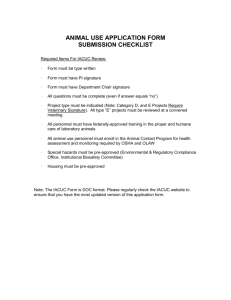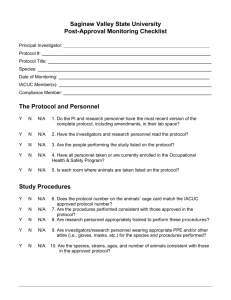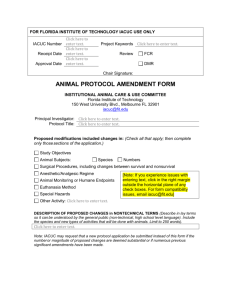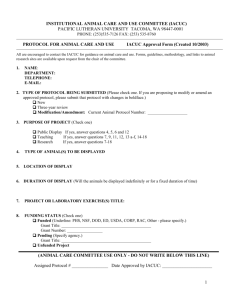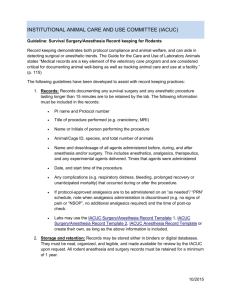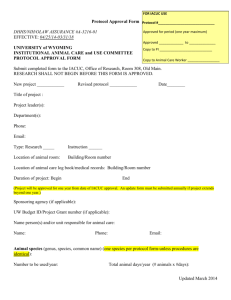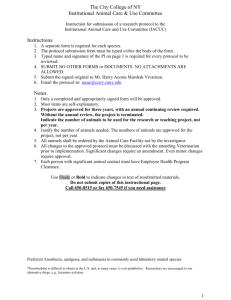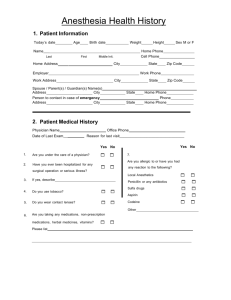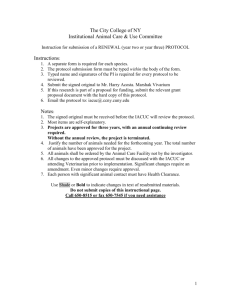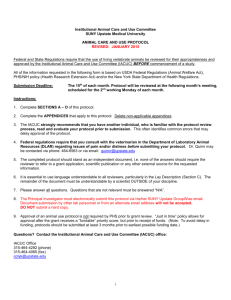ANIMAL USE APPLICATION FORM - Florida Institute of Technology
advertisement
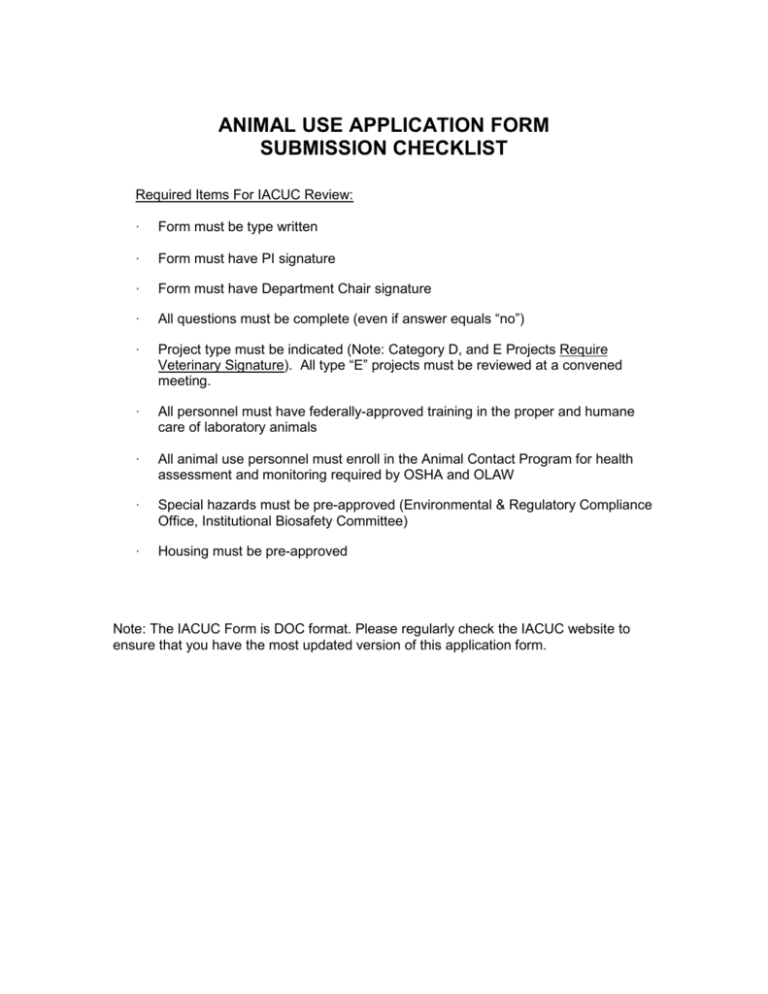
ANIMAL USE APPLICATION FORM SUBMISSION CHECKLIST Required Items For IACUC Review: · Form must be type written · Form must have PI signature · Form must have Department Chair signature · All questions must be complete (even if answer equals “no”) · Project type must be indicated (Note: Category D, and E Projects Require Veterinary Signature). All type “E” projects must be reviewed at a convened meeting. · All personnel must have federally-approved training in the proper and humane care of laboratory animals · All animal use personnel must enroll in the Animal Contact Program for health assessment and monitoring required by OSHA and OLAW · Special hazards must be pre-approved (Environmental & Regulatory Compliance Office, Institutional Biosafety Committee) · Housing must be pre-approved Note: The IACUC Form is DOC format. Please regularly check the IACUC website to ensure that you have the most updated version of this application form. FOR FLORIDA INSTITUTE OF TECHNOLOGY IACUC USE ONLY IACUC Number Project Keywords Receipt Date Approval Date 2nd year approval Review 3rd year approval FCR DMR: Chair Signature: ANIMAL USE APPLICATION FORM – Field Study INSTITUTIONAL ANIMAL CARE & USE COMMITTEE Florida Institute of Technology 150 West University Blvd., Melbourne FL 32901 iacuc@fit.edu Check as applicable: New Application Renewal application including changes Renewal application w/out changes Type of Project: Category B Category C (vet signature may be required) Category D (vet signature required) Category E (vet signature and full committee review required) [Note: If you experience issues with entering text, click in the right margin outside the horizontal plane of any check boxes. For form compatibility issues, email iacuc@fit.edu] Click here to enter text. Responsible Faculty Name: Campus Address: Click here to enter text. Department: Click here to enter text. Click here to enter text. Name of Dept. Chair: Phone: Click here to enter text. E-mail: Click here to enter text. Co-PIs: Click here to enter text. Technicians Involved: Click here to enter text. Click here to enter text. Students Involved: Section A. 1. TITLE OF PROJECT: (The title should be identical to the one submitted to the funding agency. If more than one title applies, list them all here, and indicate which funding agency applies to which title). Click here to enter text. 2. SOURCE OF FUNDING: (If the proposal is sent to more than one agency and uses more than one title, explain. Once a project is awarded and funds received, the other proposals usually become void under this protocol approval. Each funded animal project must have its own Animal Use Approval Form and number. Any exceptions to this should be explained here.) Click here to enter text. 3. IS YOUR PROPOSAL SUBJECT TO INDEPENDENT PEER (MERIT) REVIEW? Type YES or NO. If YES, specify by whom, i.e. NIH study section. If NO, explain why there has been no merit review. Click here to enter text. 4. NAME and SIGNATURE OF VETERINARIAN CONTACTED FOR CONSULTING ON PAINFUL TECHNIQUES OR PROCEDURES (Categories D and E only) Name and signature of Veterinarian 5. PROPOSED STARTING DATE: (If ongoing, list the original starting date of this project). Click here to enter text. 6. NUMBER OF YEARS PROJECT IS PLANNED TO CONTINUE and/or PROGRESS REPORT OF CONTINUING PROJECT: (If this is a new project, how long will it continue? If this project has been going on for several years, or if you are renewing your old Approval Form, provide a brief explanation or progress report at this time. Include how many animals have already been used and how many more are being requested at this time). Click here to enter text. 7. LIST ALL SPECIES OF ANIMAL(S) TO BE USED, THEIR CLASSIFICATION STATUS and LIST THE TOTAL NUMBER OF ANIMALS TO BE USED FOR THIS PROJECT: (Provide common names. List the number of animals for each category. The total number must be justified in item 19. If you are updating a project that has been ongoing, indicate how many animals have already been used and how many more are needed to finish the project). SPECIES REQUESTED CATEGORY (B, C, D, E) TOTAL NUMBER Click here to enter text. Click here to enter text. Click here to enter text. 8. DOES YOUR ANIMAL USE INVOLVE SPECIAL HAZARDS? IF YES, APPROVAL BY THE FIT ENVIRONMENTAL & REGULATORY COMPLIANCE OFFICE AND/OR INSTITUTIONAL BIOSAFETY COMMITTEE IS REQUIRED. REFER TO SECTION C FOR COMMON HAZARDS USED IN RESEARCH. Special hazards approval is (check as applicable): Not applicable Incomplete Complete and/or pending review and approval by FIT’s: ERC IBC 9. WHERE WILL YOU GET YOUR ANIMALS? (List the names of sites or locations where you will encounter/collect/capture). Click here to enter text. 10. WHAT WILL HAPPEN TO YOUR ANIMALS AT THE END OF THIS PROJECT? (Answer for all species listed in item 7). Transfer to other projects (explain): Click here to enter text. Adoption or resale (explain): Click here to enter text. Return to the wild (explain): Click here to enter text. Euthanized (Explain the method to be used. If you are using a drug(s), you must indicate the name, dose and route of the drug. If the method you use is not approved by the AVMA, you need to justify it and have it approved by this Committee. If you are unsure about your method of euthanasia, consult a DVM. Cervical dislocation and decapitation of animals requires prior sedation. If you cannot sedate the animals prior to cervical dislocation or decapitation, you must give good reasons to justify the withholding of sedatives. If you cannot sedate animals prior to cervical dislocation or decapitation, describe the training or experience acquired for the person using this method). Click here to enter text. 11. SEARCHING FOR ALTERNATIVES TO PAINFUL PROCEDURES: PROPOSED ACTIVITIES OR SIGNIFICANT CHANGES IN ONGOING ACTIVITIES AS STATED IN RESEARCH PROTOCOLS MUST MEET THE FOLLOWING FEDERAL REQUIREMENT: (only for Category Type C, D or E procedures) Subpart C, section 2.31 the USDA standards states: “The principal investigator has considered alternatives to procedures that may cause more than momentary or slight pain or distress to the animals, and has provided a written narrative description of the methods and sources, e.g. the Animal Welfare Information Center, used to determine that alternatives were not available." Examples of sources: biological abstracts, index medicus. Medline, CRIS, Animal Welfare Information Center (AWIC).” Information provided here must include database(s) and keyword(s) used in search. If the project is in the C, D or E category, you must make a narrative statement here. A sample narrative statement could be as follows: “I have considered alternatives to the use of [identify the painful procedure] and have found none that are available. The database(s) searched included a [list the date of the search] search of [list databases] for the years [list the range of years searched] of the words [list the key words searched]”. Or you can make a similar narrative statement regarding your consideration of alternatives. Click here to enter text. 12. DESCRIPTION OF ANIMAL PROJECT in NONTECHNICAL TERMS (Include a statement of your experimental hypothesis (or teaching objectives) written in lay terms so it can be understood by the general public (non-technical, high school level language). Include in your description what possible contributions your work might make to the broad disciplines of human/animal well-being or the expansion of human knowledge. Limit to 250 words). Click here to enter text. 13. JUSTIFICATION FOR USING THIS PARTICULAR SPECIES (Common statements have included: animal size, compatibility with previous studies, known susceptibility, existing knowledge database, and the information is intended for use in this species). Click here to enter text. 14. DESCRIPTION OF ALL ANIMAL PROCEDURES TO BE USED IN THIS STUDY (If performing injections, inoculations or blood withdrawals, describe the dosages, sites, volumes, routes, and schedules involved; radiation (dosage, isotope and schedule); restraining procedures if longer than several hours and any other procedures (excluding surgery). If these procedures are performed outside the animals’ holding area, state location (building & room) where procedures will be performed. Description of surgical procedures should be given in another item). Click here to enter text. 15. WHAT ARE THE EFFECTS OR SYMPTOMS YOU EXPECT TO SEE FROM THESE ANIMALS? (Will you expect the animals to experience pain, discomfort, or distress? Indicate the nature of the pain, discomfort, or distress: how it will be recognized, what measures you will take to either end the distress or provide relief). If you do not expect to see any symptoms, or if symptoms occur that you did not expect make a statement that describes the procedures for treatment of sick animals including: how often you will observe your animals, criteria for treatment, euthanasia or veterinary consult, name, dose, and route of drugs used for treatment and euthanasia. If you are providing analgesics supply their generic names, route of administration, doses, and dosing intervals; be accurate. A consultation with a veterinarian may be advisable if you are unfamiliar with the species or the extent of the pain. If death is used as an end point, explain why animals cannot be euthanized. Click here to enter text. 16. JUSTIFICATION OF YOUR ANIMAL NUMBERS: (Provide sufficient detail; explain animal groupings, any replications and anticipated wastage or training usage. This number should match the number you listed in item 7. State the proposed sample size and estimate (or explain) the statistical power related to testing your hypothesis. A table is a good way to present this information: Steroid Group Non-steroid Group TOTAL 20 min Post inj. 40 min Post inj. n= 4 n= 4 n= 4 n= 4 8 60 min Post inj. 8 n= 4 n= 4 8 = 24 + 5 = 29 If additional animals are needed for training or for replacements, make an additional entry here as well. For example, 5 additional animals will be needed to refine this technique or to train personnel before we can actually start the study. 16-1. How many animals will be needed for this project? Click here to enter text. 16-2. How many experimental groups, replications, trials, etc. are required? Click here to enter text. 16-3. How did you determine that the sample size, number of groups, replications, trials, etc. are appropriate, as they relate to the number of animals requested? Click here to enter text. Or, if your animals are being used for instructional purpose supply the following additional details: (a) Average class size Click here to enter text. (b) Teacher to student ratio Click here to enter text. (c) If offcampus, give location and details of veterinary supervision, if needed. Click here to enter text. (d) If you use a syllabus or provide handouts regarding the use of animals, include them as an appendix to this Animal Use Approval Form Appendices are included as follows: (1) More than (1) 17. WILL ANIMALS BE SUBJECTED TO EXCESSIVE RESTRAINT? Type YES or NO. (The amount of restraint usually performed with experimental animals is minimal-- minutes rather than hours. If “YES” explain and provide justification. Examples of excessive restraint include, primates restrained in chairs, animals "tethered" with leash or catheter, metabolic cages where animals are unable to turn around). Click here to enter text. 18. WILL ANIMALS EXPERIENCE ANY ELECTRICAL SHOCK? Type YES or NO. (If yes, provide intensity, length and frequency of stimulus, circumstances of the shock and if the animal can get away from it.). Click here to enter text. 19. WILL FREUND’S COMPLETE ADJUVANT BE USED? Type YES or NO. (If yes, explain why you have chosen not to use other less irritating adjuvants, like RIBI or TiterMax. Provide details of the concentration of FCA in the injection, total volume injected, routes, sites and number of injections). Click here to enter text. 20. WILL ANIMALS UNDERGO ANY FOOD OR WATER RESTRICTIONS IN EXCESS OF 24 HOURS? THIS INCLUDES FASTING FOR SURGERY. Type YES or NO. (If you are withholding food and/or water from animals in excess of 24 hours, explain why this is necessary and how you will monitor the animals to ensure that they are not excessively stressed by the protocol. The daily monitoring of body weights is usually required for food and/or water restrictions in excess of 24 hours). Click here to enter text. 21. WILL ANIMALS BE SEDATED OR ANESTHETIZED FOR RESTRAINT OR SURGERY? Type YES or NO. (If yes, provide details of the drugs (generic names), dose, and route, how you will monitor the animal's level of sedation or anesthesia. Anesthesia and monitoring details are needed for both survival and non-survival surgical procedures). Click here to enter text. 22. WILL PARALYZING AGENTS (MUSCLE RELAXANTS, like pancuronium) BE USED TO RESTRAIN YOUR ANIMALS? Type YES or NO. (If yes, explain why this is necessary and how you will determine that an animal is not without anesthesia, awake, and fully able to experience pain. In situations where there is no surgery or painful procedure involved and paralysis has to be used in conscious animals, full justification is required as well as details of how the animal's comfort needs will be met. Investigators unfamiliar with the use of muscle relaxants in animal species should seek a veterinary consultation as there are very marked species differences that could void a study if unappreciated). Click here to enter text. 23. WILL YOU BE USING AN INHALANT ANESTHETIC? Type YES or NO. (Anesthetic waste gases are classified as environmental hazards. These gases must be used in a fume hood or have a gas scavenging system in place. The use of diethyl ether, as an anesthetic agent, is prohibited because of its flammability). Click here to enter text. 24. WILL YOU BE PERFORMING NON-SURVIVAL SURGERY? Type YES or NO. (If yes, explain the surgical procedures in detail. Include the surgical approach and organs involved, the monitoring and supportive care provided during surgery, how long the animals will be anesthetized during this procedure and when euthanasia occurs. Include the means of maintaining and monitoring body temperature, fluid balance, heart and respiratory rate. Emphasize how you will ensure the animal does not recover consciousness and how euthanasia is performed). Click here to enter text. 25. WILL YOU BE PERFORMING SURVIVAL SURGERY? Type YES or NO. (Provide a description of the surgical procedure, the immediate recovery care, and postoperative care. Include the surgical approach, organs involved, implants and method of skin closure. The use of silk to close the skin is not acceptable. Identify a non-wicking material to use to close the skin. It is also necessary to describe the monitoring of body temperature, fluid balance, and heart and respiratory rate. Indicate post-operative care arrangements after normal duty hours, weekends, and holidays). Click here to enter text. 26. LOCATION OF ANIMAL SURGERY: (If animal surgery is to be done, provide the building and/or room number). Click here to enter text. 27. WILL MORE THAN ONE SURGICAL PROCEDURE BE PERFORMED? Type YES or NO. (If more than one major survival surgical procedure is to be performed on an individual animal, explain the procedures and their sequencing. Scientific justification is required if an animal is to be used for more than one major operative procedure from which it is allowed to recover. Major surgery is defined as penetration and exposure of a body cavity and/or any procedure that has the potential to produce permanent impairment of physical or physiological functions. Economic considerations are not an adequate reason for multiple surgeries on an individual animal). Click here to enter text. 28. LIST ALL PERSONNEL CONTACTING ANIMALS: (List all persons involved with this project who will be contacting animals. Persons listed below will be contacted with information regarding this program. For most academic classes, the students do not have substantial animal contact to warrant listing their names here. Substantial animal contact is intended to describe those individuals who would be at risk from REPEATED aerosol exposure (allergies) or physical exposure (bites) from their contacting the animals listed above. Where turnover of students makes this listing impractical, the instructor or responsible faculty should be listed here). NAME DEPARTMENT PHONE Click here to enter Click here to enter text. Click here to enter text. text. 29. LIST TRAINING OF ALL PERSONNEL LISTED ABOVE: (It is required that personnel, including PIs, are properly trained in the animal procedures you have listed in this project. This includes animal handling, restraint and the euthanasia methods listed. Indicate their training and experience below, who trained them and where they were trained. See https://www.citiprogram.org/ to complete the required training provided by FIT and CITI. Also list how long they have been doing these procedures. You may list any Animal workshops attended). NAME LIST TRAINING AND DATE Click here to enter text. Click here to enter text. 30. IS THIS A TYPE “E” STUDY? (If this is a Type E (no relief of pain is permitted), the University is required to submit a justification for this study to the federal agencies. Include in your justification statement below, an explanation of why the use of analgesics or euthanasia is not permitted. It is also required that investigators consult with appropriate veterinarians before submitting their application. Make sure you have the signature of a DVM that indicates this consultation has occurred). Click here to enter text. 31. ARE ANY LOCAL, STATE OR FEDERAL PERMITS REQUIRED OF THIS ANIMAL USAGE? Type YES or NO. If YES, describe. If you already have a permit, attach a copy of the permit to this application. PERMIT TYPE CERTIFYING AGENCY EXPIRATION DATE Click here to enter text. Click here to enter text. Click here to enter text. 32. PRINCIPAL INVESTIGATOR ASSURANCES: The information I have supplied above is a complete and accurate description of all procedures involving live animals in this project. I have taken appropriate measures to ensure that I am using the appropriate number of animals to achieve my goal and that I am not unnecessarily duplicating known results. I assure that all personnel under my direction will be appropriately oriented to animal research facilities and policies and properly trained prior to handling animals. I agree to abide by the care and use policies of the institution. I certify that the individuals listed are authorized to conduct animal procedure involving animals under this proposal, have attended the required institutional training and have the requisite training in: the biology, handling, and care of the species; aseptic surgical methods and techniques (if applicable); the concept, availability, and use of research or testing methods that limit the use of animals or minimize distress; the proper use of anesthetics, analgesics, and tranquilizers (if applicable); and procedures for reporting animal welfare concerns. I certify that I will obtain approval from the IACUC before initiating any significant changes in this protocol. I certify that I am familiar with and will comply with all pertinent institutional, local, state, and federal rules and policies. I, the principal investigator, am responsible for this protocol and all amendments. Signature of Animal Compliance Officer Click here to enter text. Date Click here to enter text. Required before Department Chair Signature Signature of Principal Investigator Date Signature of Department Chair Click here to enter text. Date Section B. FOR REFERENCE ONLY ANIMAL USE CLASSIFICATION (CATEGORIES B, C, D, E) In the Animal Use Approval Forms you are asked to classify the project according to the level of perceived pain / stress / distress. Category B animals are those that are being "bred, conditioned, or held for use in teaching, testing, experiments, research, or surgery but not yet used for such purposes." These animals have not been used for any research procedure, however minor. Category B is the place to put breeders and other animals that are not undergoing any experimental procedures. Category C animals are not subjected to procedures that involve pain or distress or would require the use of pain-relieving drugs. Routine procedures such as injections and blood sampling from veins that produce only mild, transient pain or discomfort are reported in this category. Another example of category C procedures is an observational study of animal behavior. Animals that are euthanized before tissue collection or other manipulations are also commonly placed in this category, if no other procedures are to be performed that put them in a higher pain/distress category. Category D animals are those subjected to potentially painful procedures for which anesthetics, analgesics, or tranquilizers will be used. The important concept is that animals are given appropriate anesthesia and/or pain relief to limit their pain and distress as much as possible. Examples of category D procedures are • Surgery conducted with appropriate anesthesia and postoperative analgesia. • Rodent retroorbital eye bleeding performed under anesthesia. • Primate tattooing performed for identification under anesthesia. • Removal of a small tumor under local or general anesthesia. • Use of analgesia after an animal's skin is exposed to UV light to cause a "sunburn" • Terminal exsanguination (euthanasia by removal of blood) under anesthesia. Category E animals are those that are subjected to painful or stressful procedures without the use of anesthetics, analgesics, or tranquilizers. Withholding of anesthetics, analgesics, or tranquilizers can only be allowed if it is scientifically justified in writing and approved by the IACUC. Examples of category E procedures are lethal dose studies (e.g., LD50 studies) that allow animals to die without intervention, pain studies that would not be possible if pain-relieving agents were administered, and psychological conditioning experiments that involve painful stimuli such as a noxious electrical shock that cannot immediately be avoided by an animal. By law, the institution must annually report all category E procedures to the USDA and include a scientific justification supporting the IACUC's decision to approve them. Often, the justification given by the researcher on the animal forms submitted to the IACUC is used for the annual report. It is important for information on category E procedures to be complete and accurate. Once submitted to the USDA, this information will likely be available to the public through a Freedom of Information Act request. Section C. SPECIAL HAZARDS Should the project involve the use of any of the following special hazards, approval is required from FIT’s Environmental Regulatory and Compliance Office and must be received prior to the project implementation. · · · · · · · · · · · · · · · · · · · Acute toxins Animal carcasses Blood, blood products, or human tissue Chemical agents Controlled substances / drugs Hazardous chemicals: toxic, reactive, corrosive, explosive, carcinogenic Hazardous waste (this may or may not be generated from the above chemicals) Human or animal pathogens Materials of animal origin Medical or biological waste (this may or may not be generated from the above materials) Non-ionizing radiation (laser, microwave, UV or other) Pathogenic microorganism: Human or Animal Radiation producing machines Radioactive material – please list isotope: Radioactive waste (this may or may not be generated from above isotopes) Recombinant DNA/RNA Regulated bioagents Tax-free alcohol Other (must describe in the form) Contact the FIT Environmental Regulatory and Compliance Office at: http://www.fit.edu/erc/ hazwaste@fit.edu
